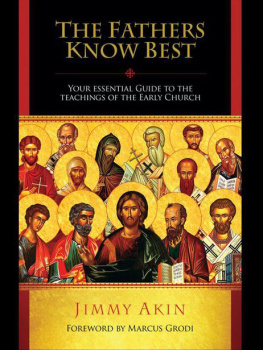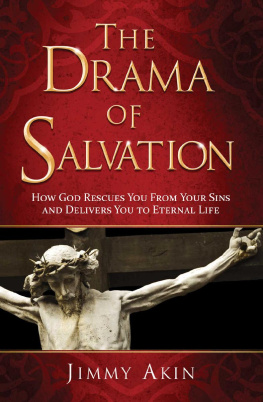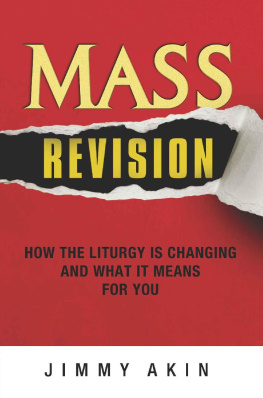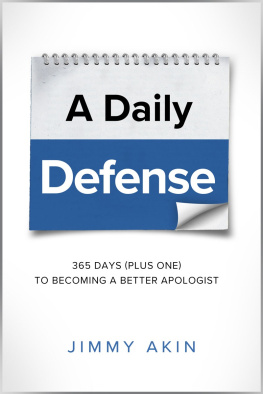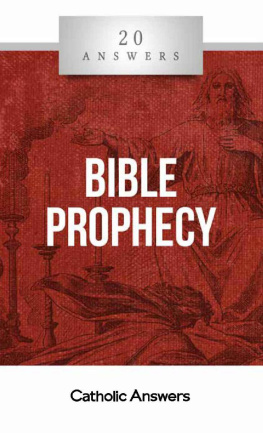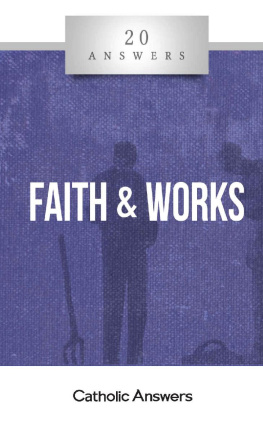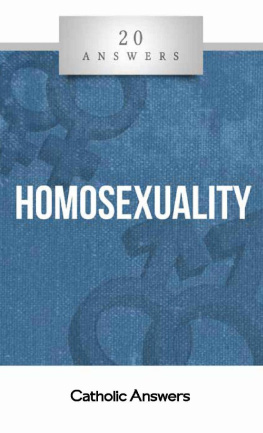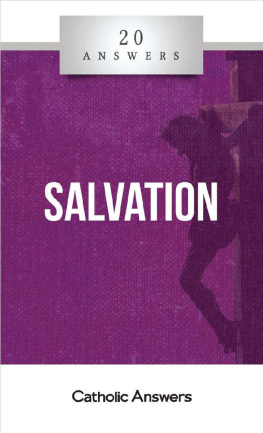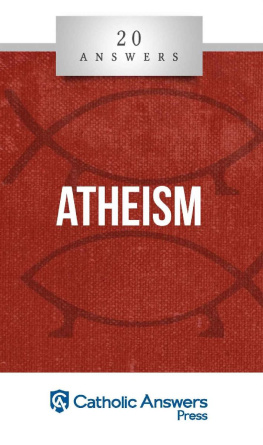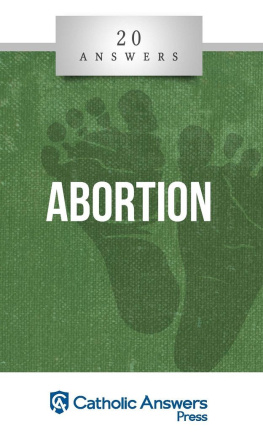Jimmy Akin - 20 Answers- Bible Difficulties (20 Answers Series from Catholic Answers Book 29)
Here you can read online Jimmy Akin - 20 Answers- Bible Difficulties (20 Answers Series from Catholic Answers Book 29) full text of the book (entire story) in english for free. Download pdf and epub, get meaning, cover and reviews about this ebook. year: 2018, publisher: Catholic Answers Press, genre: Religion. Description of the work, (preface) as well as reviews are available. Best literature library LitArk.com created for fans of good reading and offers a wide selection of genres:
Romance novel
Science fiction
Adventure
Detective
Science
History
Home and family
Prose
Art
Politics
Computer
Non-fiction
Religion
Business
Children
Humor
Choose a favorite category and find really read worthwhile books. Enjoy immersion in the world of imagination, feel the emotions of the characters or learn something new for yourself, make an fascinating discovery.

- Book:20 Answers- Bible Difficulties (20 Answers Series from Catholic Answers Book 29)
- Author:
- Publisher:Catholic Answers Press
- Genre:
- Year:2018
- Rating:4 / 5
- Favourites:Add to favourites
- Your mark:
- 80
- 1
- 2
- 3
- 4
- 5
20 Answers- Bible Difficulties (20 Answers Series from Catholic Answers Book 29): summary, description and annotation
We offer to read an annotation, description, summary or preface (depends on what the author of the book "20 Answers- Bible Difficulties (20 Answers Series from Catholic Answers Book 29)" wrote himself). If you haven't found the necessary information about the book — write in the comments, we will try to find it.
Jimmy Akin: author's other books
Who wrote 20 Answers- Bible Difficulties (20 Answers Series from Catholic Answers Book 29)? Find out the surname, the name of the author of the book and a list of all author's works by series.
20 Answers- Bible Difficulties (20 Answers Series from Catholic Answers Book 29) — read online for free the complete book (whole text) full work
Below is the text of the book, divided by pages. System saving the place of the last page read, allows you to conveniently read the book "20 Answers- Bible Difficulties (20 Answers Series from Catholic Answers Book 29)" online for free, without having to search again every time where you left off. Put a bookmark, and you can go to the page where you finished reading at any time.
Font size:
Interval:
Bookmark:
20 Answers
Bible Difficulties
Jimmy Akin

20 Answers: Bible Difficulties
Jimmy Akin
2018 Catholic Answers
All rights reserved. Except for quotations, no part of this book may be reproduced or transmitted in any form or by any means, electronic or mechanical, including photocopying, recording, uploading to the internet, or by any information storage and retrieval system, without written permission from the publisher.
Published by Catholic Answers, Inc.
2020 Gillespie Way
El Cajon, California 92020
1-888-291-8000 orders
619-387-0042 fax
catholic.com
Printed in the United States of America
978-1-68357-087-5
978-1-68357-088-2 Kindle
978-1-68357-089-9 ePub
Introduction
The books of Scripture firmly, faithfully, and without error teach that truth which God, for the sake of our salvation, wished to see confided to the sacred scriptures ( Dei Verbum 11).
So said the Second Vatican Council (19621965). And the Council was not teaching anything new. The conviction that the books of the Bible teach the truth, that they give us the word of God, has been part of the Christian faith since the very beginning.
Jesus himself declared that Scripture cannot be broken (John 10:35), and St. Paul affirmed that all Scripture is inspired by God (2 Tim. 3:16).
But not everything in Scripture is easy to understand (cf. Acts 8:3031; 2 Pet. 3:1516). Sometimes there are difficulties places where, at least at first glance, it looks like Scripture might be saying something false.
These difficulties come in two kinds. First, there are internal difficulties , where one passage of Scripture looks like it might contradict another passage. Second, there are external difficulties , where something in Scripture appears to contradict something we know independently, such as a law of science, a fact of history, or a principle of morality.
Since all truth is Gods truth, there must be solutions to these difficulties, but why do we encounter them in the first place? Partly it is because of the age in which Scripture was written. Language and culture change over time, creating challenges for usthe citizens of a much later age and culturewhen we read ancient writings. Difficulties of this kind can often be cleared up by additional study.
But more fundamentally, it seems to be part of Gods providential plan to allow us to wrestle with his word. By doing so, we learn his word even better. This is the way any learning experience works: if a teacher simply tells you the answer to every question as soon as it is posed, you wont learn the material nearly as well as if you studied it on your own, learned to apply key principles, and figured out the answers to problems for yourself.
Learning how to deal with Bible difficultiesboth internal and externalis what this short book is about. In the year 405, St. Augustine sketched our general strategy for resolving them:
Of [the canonical scriptures] alone do I most firmly believe that the authors were completely free from error. And if in these writings I am perplexed by anything which appears to me opposed to truth, I do not hesitate to suppose that either the manuscript is faulty, or the translator has not caught the meaning of what was said, or I myself have failed to understand it.
Here Augustine names three ways of dealing with Bible difficulties, by appealing to mistakes made by one of three people:
The Copyist: In his day, the printing press did not exist, and so every biblical manuscript was hand copied. Unfortunately, scribes were not divinely protected from making mistakes when they copied manuscripts, and so copyist errors are a real phenomenon.
The Translator: Augustine spoke Latin, and he did not have a good grasp of the languages in which the Bible was written (Hebrew, Aramaic, and Greek). Consequently, like most of us today, he had to use translations. God also did not protect translators from making mistakes, and there have been translation errors in the history of the Bible.
The Interpreter: Finally, Augustine humbly recognized that God did not protect himas an interpreter of the Biblefrom making mistakes. Thats an important admission, and we need to have the humility to make it, too.
In the first part of this book, we will flesh out the principles that Augustine names. After dealing briefly with copyist and translator errors (answers 1 and 2), we will take an in-depth look at the kinds of mistakes that interpreters make (answers 3 through 10).
In the second part (answers 11 through 20), we will apply those principles to key examples of Bible difficulties, and show how they can be resolved. Seeing how the principles can be applied to particular cases will also help you deal with other difficulties not covered in this book.
I hope that you find this effort interesting and informative, that it will help you learn Gods word even better, and thus help you grow closer to him.
1.How do copyist errors create Bible difficulties?
If youve ever tried copying a long piece of text by hand, you know how easy it can be to make mistakes.
Since you can only hold a few words or phrases in mind at one time, you have to keep glancing back and forth between the original text and the copy youre making. Its thus easy to lose your place. As you copy the text, you can accidentally omit a word or phraseor copy it twice.
You also might misspell a word, especially for sound-alike words (for example, to instead of too or two). You might unintentionally say the same thing in slightly different words (he didnt instead of he did not).
You might hit a place where the original is illegible, forcing you to guess at what the writer meant to say. You might even come across an error made by a previous copyist and not be sure how to fix it.
All these problems are common in hand copying, and that was the only kind of copying available before the invention of the printing press in the 1400s.
As the Bible became the most popular book in world history, thousands of copies were produced, but in the age of hand copying this also meant that thousands of tiny copyist errors were created. Each time a copyist made a mistake, it introduced a variant reading into the manuscript he was creating.
Errors have even happened in the age of the printing press. A famous example is the Adulterous Biblean edition of the King James Version that was printed in 1631. When the printers were typesetting the Ten Commandments, they accidentally left out the word not so that Exodus 20:14 ended up saying, Thou shalt commit adultery!
Sometimes skeptics portray the existence of manuscript variants as a huge problemas if all the tiny copyist errors rob us of the ability to know what the Bible originally saidbut this is not true.
Take the example of the Adulterous Bible. Its famous printer error was spotted because people knew what the Ten Commandments should say based on all the other bibles in circulationones that didnt have the typo. It was easy to compare the new copies to the old ones and see the problem.
The Bibles popularitythe fact there are thousands of early manuscriptsthus gives us a solution to the problem of copyist errors: if an individual manuscript contains slips of the pen, there are numerous other manuscripts with which we can compare it.
Over the last few centuries, a whole field of scholarshipknown as textual criticism has developed to identify the original readings of Bible passages. Scholars have surveyed and catalogued the variations copyists introduced in the early manuscripts, classified them, and developed techniques for identifying what the original readings would have been.
Next pageFont size:
Interval:
Bookmark:
Similar books «20 Answers- Bible Difficulties (20 Answers Series from Catholic Answers Book 29)»
Look at similar books to 20 Answers- Bible Difficulties (20 Answers Series from Catholic Answers Book 29). We have selected literature similar in name and meaning in the hope of providing readers with more options to find new, interesting, not yet read works.
Discussion, reviews of the book 20 Answers- Bible Difficulties (20 Answers Series from Catholic Answers Book 29) and just readers' own opinions. Leave your comments, write what you think about the work, its meaning or the main characters. Specify what exactly you liked and what you didn't like, and why you think so.

